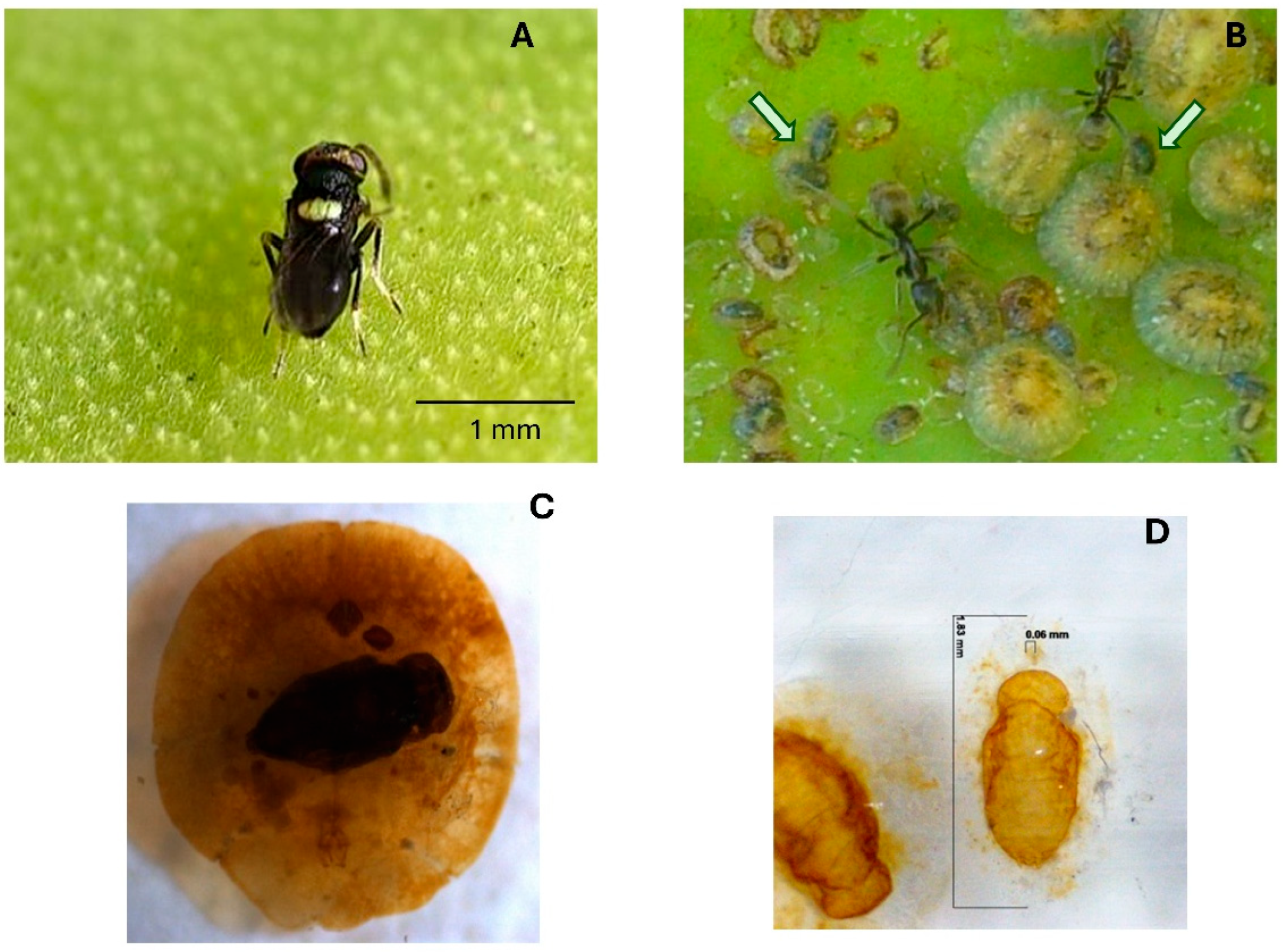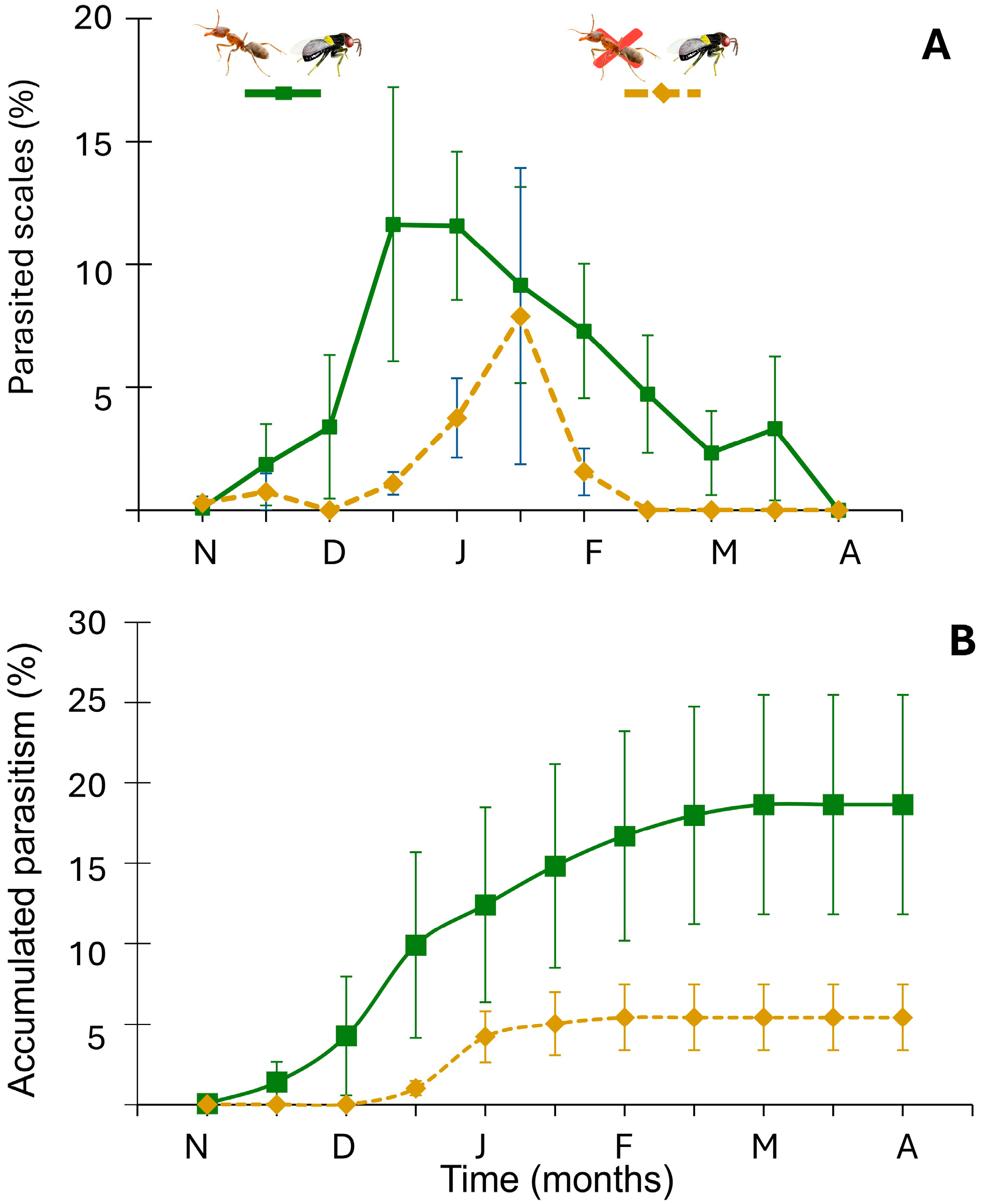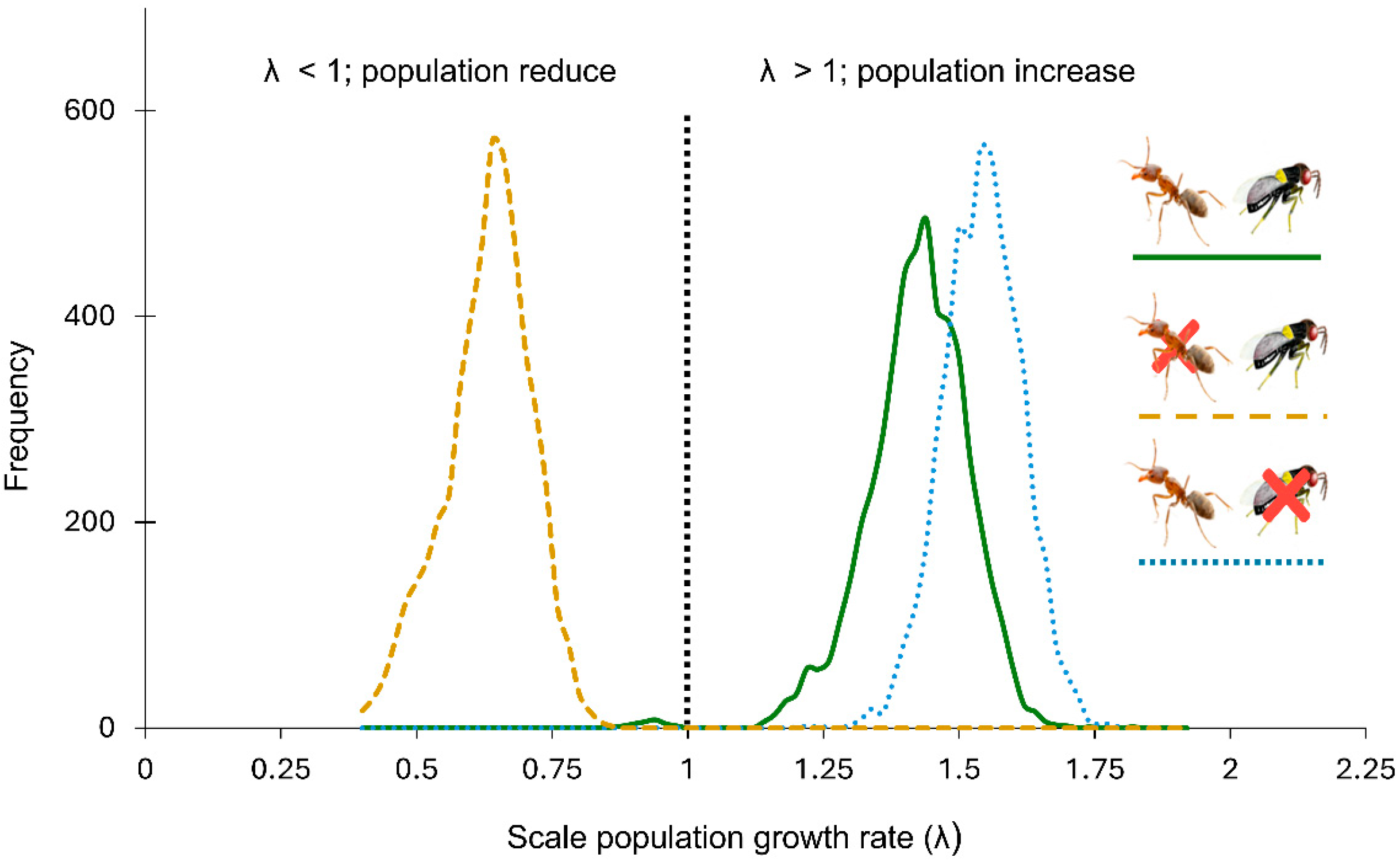Effects of Parasitism on the Population Growth of Toumeyella martinezae (Coccidae) in the Presence of Its Mutualistic Ant Liometopum apiculatum (Formicidae) in an Arid Region of Central Mexico
Simple Summary
Abstract
1. Introduction
2. Methods
2.1. Study Site and System
2.2. Parasitism Rate
2.3. Demographic Effects of Parasitoids and Ants on Scale Populations
3. Results
3.1. Parasitism Rates
3.2. Scale Population Growth Rates
4. Discussion
Author Contributions
Funding
Data Availability Statement
Acknowledgments
Conflicts of Interest
References
- Eggleton, P.; Belshaw, R. Insect parasitoids: An evolutionary overview. Phil. Trans. R. Soc. Lond. B 1992, 337, 1–20. [Google Scholar] [CrossRef]
- Chellappan, M.F.; Ranjith, M.T. Insect Parasitoids. In Parasitoids in Pest Management; Omkar, Ed.; CRC Press: Boca Raton, FL, USA, 2023; pp. 2–37. [Google Scholar]
- Cingolani, M.F.; Barakat, M.C.; Cerretti, P.; Chirinos, D.T.; Ferrer, F.; Vega, J.G.; Grenier, S.; Kondo, T.; Pape, T.; Plowes, R.; et al. Dipteran parasitoids as biocontrol agents. BioControl 2025, 70, 285–300. [Google Scholar] [CrossRef]
- Thilak, K.S.; Parmar, D.N.; Rajeshbhai, M.A. Parasitoids as Biological Control Agents in Agroecosystems. In Role of Beneficial Insects in Agricultural Ecosystems; Sarangi, S., Reddy, S.N., Guntupalli, S., Aulakh, G.K., Eds.; Textify Publishers: Lucknow, India, 2025; pp. 178–202. [Google Scholar] [CrossRef]
- Eggleton, P.; Gaston, K.J. Parasitoid species and assemblages: Convenient definition or misleading compromises? Oikos 1990, 59, 417–421. [Google Scholar] [CrossRef]
- Godfray, H.C.J. Parasitoids: Behavioral and Evolutionary Ecology; Princeton University Press: Princeton, NJ, USA, 1994; p. 67. [Google Scholar] [CrossRef]
- Forbes, A.A.; Bagley, R.K.; Beer, M.A.; Hippee, C.; Widmayer, H.A. Quantifying the unquantifiable: Why Hymenoptera, not Coleoptera, is the most speciose animal order. BMC Ecol. 2018, 18, 21. [Google Scholar] [CrossRef]
- Hamback, P.A.; Janz, N.; Braga, M.P. Parasitoid speciation and diversification. Curr. Opin. Insect Sci. 2024, 66, 101281. [Google Scholar] [CrossRef] [PubMed]
- Koul, O.; Dhaliwal, G.S. Predators and Parasitoids: An introduction. In Predators and Parasitoids; Koul, O., Dhaliwal, Eds.; Taylor and Francis: London, UK, 2003. [Google Scholar]
- Hawkins, B.A.; Cornell, H.V.; Hochberg, M.E. Predators, parasitoids, and pathogens as mortality agents in phytophagous insect populations. Ecology 1997, 78, 2145–2152. [Google Scholar] [CrossRef]
- Vet, L.E.M.; Hamerik, L.; Visser, M.E.; Wäckers, F.L. Flexibility in Host-search and Patch-use Strategies of Insect Parasitoids. In The Behavioural Ecology of Parasites; Lewis, E.E., Campbell, J.F., Sukhdeo, M.V.K., Eds.; CABI Books; CABI: Waterloo, UK, 2002. [Google Scholar] [CrossRef]
- Hajek, A. Natural Enemies: An Introduction to Biological Control; Cambridge University Press: Cambridge, UK, 2004; p. 378. [Google Scholar] [CrossRef]
- Badii, M.H.; Hernández-Ortiz, E.; Flores, A.E.; Landeros, J. Prey stage preference and functional response of Euseius hibisci to Tetranychus urticae (Acari: Phytoseiidae, Tetranychidae). Exp. Appl. Acarol. 2004, 34, 263–273. [Google Scholar]
- Paris, C.I.; Llusia, J.; Peñuelas, J. Changes in monoterpene emission rates of Quercus ilex infested by aphids tended by native or invasive Lasius ant species. J. Chem. Ecol. 2010, 36, 689–698. [Google Scholar] [CrossRef] [PubMed]
- D’Alessandro, M.; Brunner, V.; von Mérey, G.; Turlings, T.C.J. Strong Attraction of the Parasitoid Cotesia marginiventris Towards Minor Volatile Compounds of Maize. J. Chem. Ecol. 2009, 35, 999–1008. [Google Scholar] [CrossRef]
- Wei, J.; Wang, L.; Zhu, J.; Zhang, S.; Nandi, O.I.; Kang, L. Plants Attract Parasitic Wasps to Defend Themselves against Insect Pests by Releasing Hexenol. PLoS ONE 2007, 2, e852. [Google Scholar] [CrossRef]
- Riddick, E.W.; Cottrell, T.E.; Kidd, K.A. Natural enemies of the Coccinellidae: Parasites, pathogens, and parasitoids. Biol. Control. 2009, 51, 306–312. [Google Scholar] [CrossRef]
- MacFadyen, S.; Davies, A.P.; Zalucki, M.P. Assessing the impact of arthropod natural enemies on crop pests at the field scale. Insect Sci. 2015, 22, 20–34. [Google Scholar] [CrossRef]
- Majerus, M.; Sloggett, J.J.; Godeau, J.F.; Hemptinne, J.L. Interactions between ants and aphidophagous and coccidophagous ladybirds. Popul. Ecol. 2007, 49, 15–27. [Google Scholar] [CrossRef]
- Stadler, B.; Dixon, A.F.G. Ecology and Evolution of Aphid-Ant Interactions. Annu. Rev. Ecol. Evol. Syst. 2005, 36, 345–372. [Google Scholar] [CrossRef]
- Singh, A.; Zytynska, S.E.; Hanna, R.; Weisser, W.W. Ant attendance of the cotton aphid is beneficial for okra plants: Deciphering multitrophic interactions. Agric. For. Entomol. 2016, 18, 270–279. [Google Scholar] [CrossRef]
- Majer, J.D. Ant-plant interactions in the Darling Botanical District of Western Australia. In Ant-Plant Interactions in Australia; Buckley, R.C., Ed.; Geobotany; Springer: Dordrecht, The Netherlands, 1982; Volume 4. [Google Scholar] [CrossRef]
- Bristow, C.M. Differential benefits from ant attendance to two species of Homoptera on New York ironweed. J. Anim. Ecol. 1984, 53, 715–726. [Google Scholar] [CrossRef]
- Buckley, R. Ant-plant-homopteran interactions. In Advances in Ecological Research; Academic Press: Cambridge, MA, USA, 1987; pp. 53–85. [Google Scholar]
- Bristow, C.M. Are ant-aphid associations a tritrophic interaction? Oleander aphids and Argentine ants. Oecologia 1991, 87, 514–552. [Google Scholar] [CrossRef] [PubMed]
- Yui, N.; Yukari, M.; Makoto, T.; Issei, O. Mutualistic ants and parasitoid communities associated with a facultative myrmecophilous lycaenid, Arhopala japonica, and the effects of ant attendance on the avoidance of parasitism. Entomol. Sci. 2020, 23, 233–244. [Google Scholar] [CrossRef]
- Mouratidis, A.; Vacas, S.; Herrero, J.; Navarro-Llopis, V.; Dicke, M.; Tena, A. Parasitic wasps avoid ant-protected hemipteran hosts via the detection of ant cuticular hydrocarbons. Proc. Biol. Sci. 2021, 288, 20201684. [Google Scholar] [CrossRef]
- Eisner, T.; Wiemer, D.F.; Haynes, L.W.; Meinwald, J. Lucibufagins: Defensive steroids from the fireflies Photinus ignitus and P. marginellus (Coleoptera: Lampyridae). Proc. Natl. Acad. Sci. USA 1978, 75, 905–908. [Google Scholar] [CrossRef] [PubMed] [PubMed Central]
- Maschwitz, U.; Schroth, M.; Hanel, H.; Pong, T.Y. Lycaenids parasiting symbiotic plants-ant partnerships. Oecologia 1984, 64, 78–80. [Google Scholar] [CrossRef]
- Fiedler, K.; Maschwitz, U. Functional analysis of the myrmecophilous relationships between ants (Hymenoptera: Formicidae) and lycaenids (Lepidoptera: Lycaenidae)—II. Lycaenid larvae as trophobiotic partners of ants-a quantitative approach. Oecologia 1988, 75, 204–206. [Google Scholar] [CrossRef] [PubMed]
- Mason, R.T.; Fales, H.M.; Eisner, M.; Eisner, T. by a Chrysopid Larva. Naturwissenschaften 1991, 78, 28–30. [Google Scholar] [CrossRef] [PubMed]
- Völkl, W. Behavioural and morphological adaptations of the coccinellid Platynaspis luteorubra for exploiting ant-attended resources. J. Insect Behav. 1995, 8, 653–670. [Google Scholar]
- Völkl, W. The effect of ant-attendance on the foraging behaviour of the aphid parasitoid Lysiphlebus cardui. Oikos 1994, 70, 149–155. [Google Scholar] [CrossRef]
- Tena, A.; Hoddle, C.D.; Hoddle, M.S. Competition between honeydew producers in an ant-hemipteran interaction may enhance biological control of an invasive pest. Entomol. Res. 2013, 103, 714–723. [Google Scholar] [CrossRef]
- Callejas-Chavero, A.; Martínez-Hernández, D.; Flores-Martínez, A.; Moncada-Orellana, A.; Diaz-Quiñones, Y.; Vargas-Mendoza, C.F. Herbivory in cacti: Fitness effects of two herbivores, one tending ant on Myrtillocactus geometrizans (Cactaceae). In Evolutionary Ecology of Plant-Herbivore Interaction; Núñez-Farfán, J., Valverde, P.L., Eds.; Springer International Publishing: Cham, Switzerland, 2020; pp. 109–134. [Google Scholar] [CrossRef]
- Martínez-Hernández, D.G. Efecto de Liometopum apiculatum (Hymenoptera: Formicidae) Sobre la Tasa de Parasitoidismo de Toumeyella martinezi (Hemiptera: Coccidae) Asociados a Myrtillocactus geometrizans (Cactaceae) en un Matorral Xerófilo de Huichapan. Bachelor’s Thesis, Escuela Nacional Ciencias Biológicas, IPN, Ciudad de Mexico, Mexico, 26 May 2015. [Google Scholar]
- Kondo, T.; González, H. A new species of Toumeyella Cockerell (Hemiptera: Coccidae) on Myrtillocactus geometrizans (Cactaceae) from Mexico with a checklist of known species of Toumeyella in the world. Insecta Mundi 2014, 396, 1–10. [Google Scholar]
- Myartseva, S.N.; Coronado-Blanco, J.M.; Lomelí-Flores, J.R.; Martínez-Hernández, D.Y. A new genus for a new species of the family Aphelinidae (Hymenoptera: Chalcidoidea) from Mexico. Zoosyst. Ross. 2014, 23, 131–136. [Google Scholar] [CrossRef]
- MotiCImages 2000, version 1.3; Motic Hong Kong Limited: Hong Kong, 2002.
- Dean, C.B.; Lundy, E.R. Overdispersion. In Wiley StatsRef: Statistics Reference Online; Balakrishnan, N., Colton, T., Everitt, B., Piegorsch, W., Ruggeri, F., Teugels, J.L., Eds.; Wiley: Hoboken, NJ, USA, 2016. [Google Scholar] [CrossRef]
- Salinas-Ruíz, J.; Montesinos López, O.A.; Hernández Ramírez, G.; Crossa Hiriart, J. Generalized Linear Mixed Models for Non-normal Responses. In Generalized Linear Mixed Models with Applications in Agriculture and Biology; Springer: Cham, Switzerland, 2023. [Google Scholar] [CrossRef]
- JASP Team. JASP, version 0.95.1; Computer Software; JASP Team: Amsterdam, The Netherlands, 2025.
- Caswell, H. Matrix Population Models: Construction, Analysis and Interpretation; Sinauer Associates, Inc.: Sunderland, MA, USA, 2000; pp. 1–722. [Google Scholar]
- Nuñez, R. Plagas de paltos y cítricos en Perú. In Manejo de Plagas en Paltos y Cítricos; Ripa, R., Larral, P., Eds.; Instituto de Investigaciones Agropecuarias: La Cruz, Chile, 2008; pp. 324–364. [Google Scholar]
- R Core Team. R: A Language and Environment for Statistical Computing; R Foundation for Statistical Computing: Vienna, Austria, 2020; Available online: https://www.R-project.org/ (accessed on 8 September 2023).
- Pflaumer, P. Confidence intervals for population projections based on Monte Carlo methods. Int. J. Forecast. 1988, 4, 135–142. [Google Scholar] [CrossRef]
- Gurr, G.M.; Wratten, S.D. Integrated biological control: A proposal for enhancing success in biological control. Int. J. Pest Manag. 1999, 45, 81–84. [Google Scholar] [CrossRef]
- Lill, J.T.; Marquis, R.J.; Ricklefs, R.E. Host plants influence parasitism of forest caterpillars. Nature 2002, 417, 170–173. [Google Scholar] [CrossRef]
- Hance, T.; van Baaren, J.; Vernon, P.; Boivin, G. Impact of extreme temperatures on parasitoids in a climate change perspective. Annu. Rev. Entomol. 2007, 52, 107–126. [Google Scholar] [CrossRef]
- Itioka, T.; Inoue, T. The consequences of ant-attendance to the biological control of the red wax scale insect Ceroplastes rubens by Anicetus beneficus. J. Appl. Ecol. 1996, 31, 195–202. [Google Scholar] [CrossRef]
- Sadeghi-Namaghi, H.; Amiri-Jami, A. Success of aphid parasitoids and their hosts varies with ant attendance: A field study. Entomol. Sci. 2018, 21, 406–411. [Google Scholar] [CrossRef]
- Rodriguez-Saona, C.; Urbaneja-Bernat, P.; Salamanca, J.; Garzón-Tovar, V. Interactive effects of an herbivore-induced plant volatile and color on an insect community in Cranberry. Insects 2020, 11, 524. [Google Scholar] [CrossRef]
- Fei, M.; Gols, R.; Harvey, J.A. The biology and ecology of parasitoid wasps of predatory arthropods. Annu. Rev. Entomol. 2023, 68, 109–128. [Google Scholar] [CrossRef]
- Suarez-Villavicencio, H. Análisis de la Distribución Espacial de Toumeyella martinezae (Coccidae) en una Población de Myrtillocactus geometrizans (Cactacea) en un Matorral Xerófilo de Hidalgo. Bachelor’s Thesis, Escuela Nacional Ciencias Biológicas, IPN, Ciudad de Mexico, Mexico, 20 August 2024. [Google Scholar]
- Vet, L.; Godfray, C. Multitrophic interactions and parasitoid behavioural ecology. In Behavioral Ecology of Insect Parasitoids: From Theoretical Approaches to Field Applications; Wiley: Hoboken, NJ, USA, 2008; pp. 229–252. [Google Scholar]
- Moncada-Orellana, A. Competencia Entre Toumeyella martinezae (Coccidae) y Opuntiaspis philococcus (Diaspididae) Asociadas a Myrtillocactus geometrizans (Cactaceae) en Presencia y Ausencia de la Hormiga Liometopum apiculatum (Formicidae). Master’s Thesis, Escuela Nacional Ciencias Biológicas, IPN, Ciudad de Mexico, Mexico, 15 August 2019. [Google Scholar]
- Moncada-Orellana, A.J.; Callejas-Chavero, A.; Sánchez-Colón, S.; Vargas-Mendoza, C.F. Interspecific competition for space between two hemipteran phytophagous insects associated with Myrtillocactus geometrizans (garambullo) and its consequences for their population structure. In Entomologia Experimentalis et Applicata; Wiley: Hoboken, NJ, USA, 2025; pp. 1–12. [Google Scholar] [CrossRef]
- Callejas-Chavero, A.; Martínez-Hernández, D.G.; Vargas-Mendoza, C.F.; Flores-Martínez, A. Herbivory in Myrtillocactus geometrizans (Cactaceae): Do parasitoids provide indirect defense or a direct advantage? Plants 2023, 12, 47. [Google Scholar] [CrossRef] [PubMed]
- Menalled, F.D.; Costamagna, A.C.; Marino, P.C.; Landis, D.A. Temporal variation in the response of parasitoids to agricultural landscape structure. Agric. Ecosyst. Environ. 2002, 96, 29–35. [Google Scholar]
- Kaneko, S. Seasonal population changes of five parasitoids attacking the scale insect Nipponaclerda biwakoensis on the common reed, with special reference to predation by wintering birds. Entomol. Sci. 2005, 8, 323–329. [Google Scholar]
- Xu, T.; Chen, L. Chemical communication in ant-hemipteran mutualism: Potential implications for ant invasions. Curr. Opin. Insect Sci. 2021, 45, 121–129. [Google Scholar] [CrossRef]
- Barzman, M.S.; Daane, K.M. Host-handling behaviours in parasitoids of the black scale: A case for ant-mediated evolution. J. Anim. Ecol. 2001, 70, 237–247. [Google Scholar]
- Völkl, W. Parasitoid learning during interactions with ants: How to deal with an aggressive antagonist. Behav. Ecol. Sociobiol. 2001, 49, 135–144. [Google Scholar] [CrossRef]
- Kaneko, S. Different Impacts of Two Species of Aphid-attending Ants with Different Aggressiveness on the Number of Emerging Adults of the Aphid’s Primary Parasitoid and Hyperparasitoids. Ecol. Res. 2003, 18, 199–212. [Google Scholar] [CrossRef]
- Orr, M.R.; De Camargo, R.X.; Benson, W.W. Interactions between ant species increase arrival rates of an ant parasitoid. Anim. Behav. 2003, 65, 1187–1193. [Google Scholar] [CrossRef]
- Heil, M. Indirect defence via tritrophic interactions. New Phytol. 2008, 178, 41–61. [Google Scholar] [CrossRef] [PubMed]
- Billick, I.; Hammer, S.; Reithel, J.S.; Abbot, P. Ant–aphid interactions: Are ants’ friends, enemies, or both? Ann. Entomol. Soc. Am. 2007, 100, 887–892. [Google Scholar] [CrossRef]
- Nowak, H.; Komor, E. How aphids decide what is good for them: Experiments to test aphid feeding behaviour on Tanacetum vulgare (L.) using different nitrogen regimes. Oecologia 2010, 163, 973–984. [Google Scholar] [CrossRef] [PubMed]
- Tena, A.; Wäckers, F.L.; Heimpel, G.E.; Urbaneja, A.; y Pekas, A. Parasitoid Nutritional Ecology in a Community Context: The Importance of Honeydew and Implications for Biological Control. Curr. Opin. Insect Sci. 2016, 14, 100–104. [Google Scholar] [CrossRef]
- Migani, V.; Ekesi, S.; Merkel, K.; Hoffmeister, T. At lunch with a killer: The effect of weaver ants on host-parasitoid interactions on mango. PLoS ONE 2017, 12, e0170101. [Google Scholar] [CrossRef]
- Dicke, M.; Grostal, P. Chemical detection of natural enemies by arthropods: An ecological perspective. Annu. Rev. Ecol. Syst. 2001, 32, 1–23. [Google Scholar] [CrossRef]
- González Villa, H. Efecto del Parasitoidismo y Mutualismo Sobre la Demografía de Toumeyella martinezae (Hemíptera: Coccidae) Asociada a Myrtillocactus geometrizans (Cactaceae) en un Matorral Xerófilo de Huichapan, Hidalgo. Masters’ Thesis, Escuela Nacional Ciencias Biológicas, IPN, Ciudad de Mexico, Mexico, 28 January 2021. [Google Scholar]
- Miksanek, J.R.; Heimpel, G.E. A matrix model describing host–parasitoid population dynamics: The case of Aphelinus certus and soybean aphid. PLoS ONE 2019, 14, e0218217. [Google Scholar] [CrossRef] [PubMed]
- Nelson, A.S.; Mooney, K.A. The evolution and ecology of interactions between ants and honeydew-producing hemipteran insects. Annu. Rev. Ecol. Evol. Syst. 2022, 53, 379–402. [Google Scholar] [CrossRef]
- Giovanni, B.; Magagnoli, S.; Casoli, L.; Profeta, M.; Grasso, D.A.; Schifani, E.; Giannetti, D.; Parrilli, M. Use of Sugar Dispensers at Lower Density Can Decrease Mealybug (Hemiptera: Pseudococcidae) Infestation in Vineyards by Disrupting Ants. Insects 2025, 16, 468. [Google Scholar] [CrossRef] [PubMed]



| With Ants and Parasitoids | λ = 1.4132 (1.2062–1.5744) | |||||
| Egg | E1 | E2 | E3 | E4 | Adult | |
| Egg | 0 | 0 | 0 | 0 | 69.75 | 371.82 |
| E1 | 0.7111 | 0.0078 | 0 | 0 | 0 | 0 |
| E2 | 0 | 0.7111 | 0.1944 | 0 | 0 | 0 |
| E3 | 0 | 0 | 0.3451 | 0.5350 | 0 | 0 |
| E4 | 0 | 0 | 0 | 0.0498 | 0.6010 | 0 |
| Adult | 0 | 0 | 0 | 0 | 0.2020 | 0.9200 |
| With Ants, Parasitoids Excluded | λ = 1.5324 (1.3873–1.6692) | |||||
| Egg | E1 | E2 | E3 | E4 | Adult | |
| Egg | 0 | 0 | 0 | 0 | 56.33 | 585.85 |
| E1 | 0.5179 | 0 | 0 | 0 | 0 | 0 |
| E2 | 0 | 0.5179 | 0.1877 | 0 | 0 | 0 |
| E3 | 0 | 0 | 0.4110 | 0.5057 | 0 | 0 |
| E4 | 0 | 0 | 0 | 0.1009 | 0.7152 | 0 |
| Adult | 0 | 0 | 0 | 0 | 0.1840 | 0.9876 |
| Ant Excluded, Parasitoid Allowed | λ = 0.6224 (0.4600–0.7620) | |||||
| Egg | E1 | E2 | E3 | E4 | Adult | |
| Egg | 0 | 0 | 0 | 0 | 69.75 | 371.82 |
| E1 | 0.7784 | 0.0227 | 0 | 0 | 0 | 0 |
| E2 | 0 | 0.7784 | 0.2533 | 0 | 0 | 0 |
| E3 | 0 | 0 | 0.3652 | 0.5136 | 0 | 0 |
| E4 | 0 | 0 | 0 | 0.0267 | 0.2026 | 0 |
| Adult | 0 | 0 | 0 | 0 | 0.0100 | 0.0100 |
Disclaimer/Publisher’s Note: The statements, opinions and data contained in all publications are solely those of the individual author(s) and contributor(s) and not of MDPI and/or the editor(s). MDPI and/or the editor(s) disclaim responsibility for any injury to people or property resulting from any ideas, methods, instructions or products referred to in the content. |
© 2025 by the authors. Licensee MDPI, Basel, Switzerland. This article is an open access article distributed under the terms and conditions of the Creative Commons Attribution (CC BY) license (https://creativecommons.org/licenses/by/4.0/).
Share and Cite
Callejas-Chavero, A.; Vargas-Mendoza, C.F.; González-Villa, H.; Flores-Martínez, A. Effects of Parasitism on the Population Growth of Toumeyella martinezae (Coccidae) in the Presence of Its Mutualistic Ant Liometopum apiculatum (Formicidae) in an Arid Region of Central Mexico. Insects 2025, 16, 1002. https://doi.org/10.3390/insects16101002
Callejas-Chavero A, Vargas-Mendoza CF, González-Villa H, Flores-Martínez A. Effects of Parasitism on the Population Growth of Toumeyella martinezae (Coccidae) in the Presence of Its Mutualistic Ant Liometopum apiculatum (Formicidae) in an Arid Region of Central Mexico. Insects. 2025; 16(10):1002. https://doi.org/10.3390/insects16101002
Chicago/Turabian StyleCallejas-Chavero, Alicia, Carlos Fabián Vargas-Mendoza, Humberto González-Villa, and Arturo Flores-Martínez. 2025. "Effects of Parasitism on the Population Growth of Toumeyella martinezae (Coccidae) in the Presence of Its Mutualistic Ant Liometopum apiculatum (Formicidae) in an Arid Region of Central Mexico" Insects 16, no. 10: 1002. https://doi.org/10.3390/insects16101002
APA StyleCallejas-Chavero, A., Vargas-Mendoza, C. F., González-Villa, H., & Flores-Martínez, A. (2025). Effects of Parasitism on the Population Growth of Toumeyella martinezae (Coccidae) in the Presence of Its Mutualistic Ant Liometopum apiculatum (Formicidae) in an Arid Region of Central Mexico. Insects, 16(10), 1002. https://doi.org/10.3390/insects16101002







